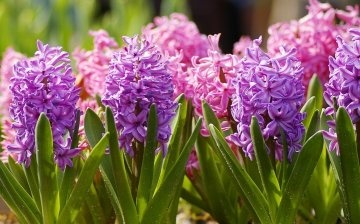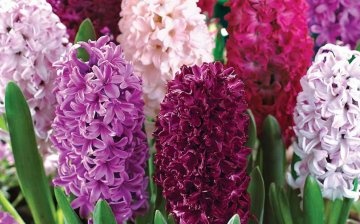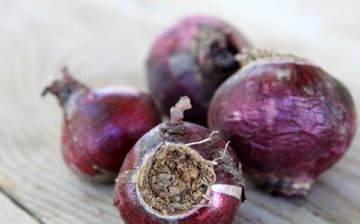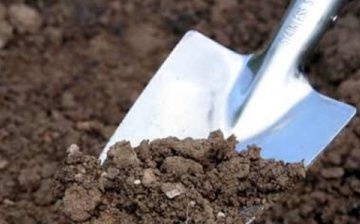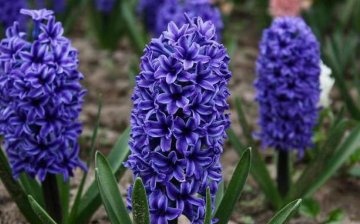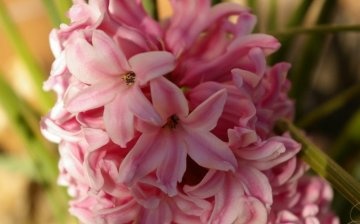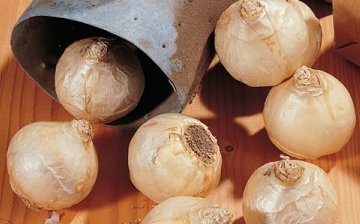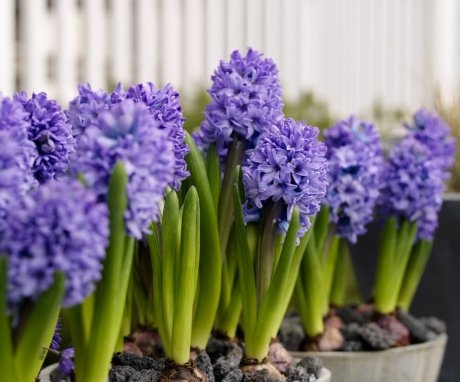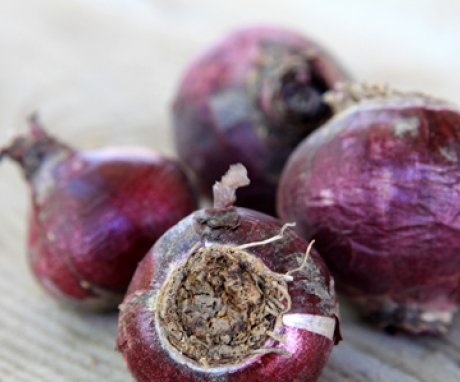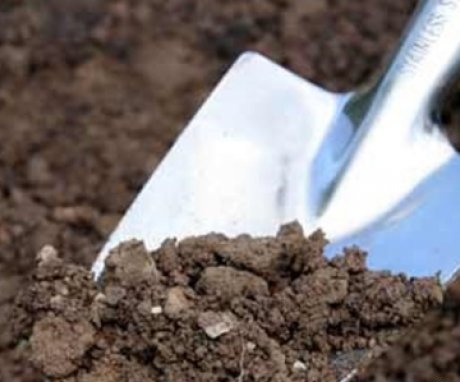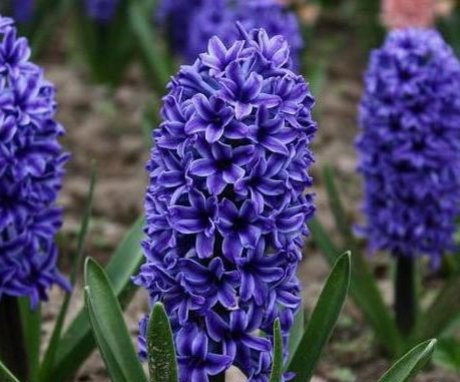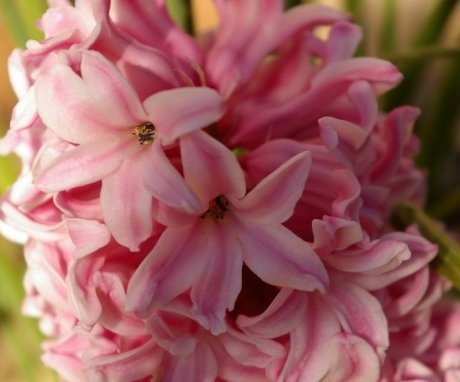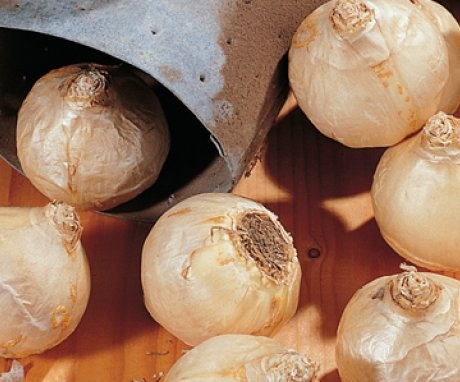Hyacinth: planting and caring for flowers in the garden
The appearance of the first flowers immediately after the snow melts is an important event in the process of awakening nature after hibernation. Typically, garden primroses are bulbous plants. One of them hyacinthwhich owes its popularity to Dutch breeders. They are leaders in the cultivation of ornamental flowers.
Although Holland is considered the center of hyacinth cultivation, it is home to the countries of the Middle East and the Mediterranean. Bright inflorescences of various shades have become a decoration of the spring garden at all latitudes of the globe. But the capriciousness of a flower requires skill and knowledge of its cultivation and care.
Content:
- Hyacinth - structural features
- The best varieties and types of flower for growing
- Bulbous plant propagation methods
- Planting a flower: terms and rules
- Tips for good hyacinth care
- Disease prevention, primrose pest control
- Rules for storing plant bulbs
Hyacinth - structural features
At the heart of hyacinth - a bulb consisting of succulent lower leaves. A stem no more than thirty centimeters high departs from it. It is a continuation of the bulbous base - the bottom. As soon as the hyacinth blooms, the stem, together with narrow-shaped leaves, dries up and falls off. At the same time, a bud is formed inside the bulb, which will later turn into a new plant. She is like the basis of the flower of the next year. In addition, baby bulbs appear in the corners of the lower leaves, they are useful for the reproduction of hyacinth.
The flowers of the plant are collected in cylindrical or conical inflorescences.
The bell-shaped funnel of the perianth is decorated with lobes of petals, beautifully bent outward. Flowers are characterized by both simple and double forms. The color of the inflorescences is distinguished by a wide palette of shades - white, red, yellow, blue, lilac.
After the flowers have dried up, a fruit with three nests is formed in their place. Each of them hides two seeds with a delicate peel. Despite the short flowering period, hyacinths are bred by all gardeners who understand a lot about beauty and design.
The best varieties and types of flower for growing
The history of breeding bulbous culture has more than four centuries, therefore, almost thirty plant species are known. Biologists bred five hundred varieties of hyacinths, differing in flower shape, flowering time, color of inflorescences.
The distribution of the best types of bulbous plants can be noted:
- Among the blue hyacinths, a popular variety of early development is Maria, which blooms for sixteen days. On its dark blue petals, longitudinal stripes are drawn in a purple tone. The light blue flowers of Queen of the Blues sit on the stem for two weeks, attracting insects with a faint scent.
- Beautiful lilac flower species. Bismarck has a bright longitudinal stripe of dark tone against a pale background. And Indigo King attracts with its brilliant flowers of black and purple hue, which are located on the long arrow of fifteen centimeters.The Blue Magic variety is distinguished by purple petals with a purple tint.
- Pink hyacinths are beautiful and noble. Anna Maria possesses the tenderness of a young girl's blush. Gertrude is characterized by the brightness of dark pink inflorescences.
- Of the red hyacinth species, the early Victoria variety with red-pink inflorescences, the Scarlett of medium flowering with double bright red honey plants, is widespread.
- The delicacy of the white flowers is seen in Madame Sophie, the Snow Crystal. They belong to terry species with a height of twenty-three to twenty-eight centimeters. The flowering period is about twenty days.
- Yellow and orange hyacinths bloom later than other species. A widespread variety is the Yellow hammer with bright inflorescences that fade in the sun by the end of the period. The streets of Harlem have light yellow, creamy flowers.
The variety of shapes and palette of hyacinths makes the spring garden bright and attractive.
Bulbous plant propagation methods
There are two ways to reproduce a flower - seeds and bulbs. Breeders are engaged in the seed method, since the features of the parental qualities of the plant are embedded in the seeds. The prepared material is planted at the end of September in boxes with light and loose soil. The composition of the substrate includes leafy earth, humus and sand. The sprouts that appear are grown in greenhouses, where they are kept for two years. Only then are the plants planted in open ground. Hyacinths bloom only in the fifth or sixth year of life.
Vegetative reproduction is the most simple, accessible to everyone, and the result can be obtained quickly.
For planting, take the children formed on the bulbs. If they are well formed, then place them in the ground separately. With poor development, babies are planted together with the parent bulb, reducing the planting depth, increasing the layer mulch.
If the children do not appear for a long time, then their growth can be caused. To do this, remove the juicy roots and wipe the bottom with dry material. Cutting or cutting out the bottom stimulates the growth of children well. The resulting plants are grown for four to five years. In this way, the plant is propagated annually.
Planting a flower: terms and rules
Hyacinth bulbs are planted in the fall from September to October tenth. Early planting is not recommended, as the flowers can germinate and freeze in winter. Late planting is fraught with the fact that the bulbs will not have time to take root and will die.
Before planting, medium-sized bulbs are examined for dense, smooth bulbs. They must be disinfected by immersing them in a solution of Fundazole or potassium permanganate for thirty minutes.
features of preparation and landing:
- The planting scheme for flowering plants is as follows: the distance between large bulbs is twenty centimeters, small ones - ten. Embedding depth from fifteen to eighteen centimeters.
- A site for bulbous plants is chosen well-lit, but without an overabundance of sunlight. Strong winds can also damage hyacinths. The best place for them is an area near bushes and trees. Before planting, they dig up the ground forty centimeters deep, introducing mineral fertilizers - 70 grams of superphosphate, 15 - magnesium sulfate, 30 - potassium sulfate per square meter. For sandy soil, the amount of potash and magnesium dressing is increased.
- A layer of sand is poured at the bottom of the hole. Having put an onion there, they prepare a sandy bed for it. It will prevent excess moisture, save you from being damaged by a fungus. The soil for the plant should be loose, neutral. With excessive acidity of the soil, slaked lime is added to it. The plantings are sprinkled with mulch with a layer of five centimeters. Compost or humus acts in its role. For the winter, you can cover the area with fallen leaves or spruce branches. In early spring, the shelter is removed by mulching the site again.
Compliance with the terms and rules for planting hyacinths is important for their further growth and development.
Tips for good hyacinth care
A capricious flower requires increased attention, knowledge of agricultural technology:
- Water the flowers as the topsoil dries. If the site is under mulch, then the frequency of watering is also reduced.
- The plants are fed twice or three times during the growing season. You can lay out dry fertilizers, embedding them in the ground with a hoe, or dissolve in water and water the plantings with them. The first top dressing is applied at the beginning of spring in the form of superphosphate and nitrate (20 grams per square meter), when the buds appear, potash and phosphate dressings are necessary. After the end of flowering, 30 grams of superphosphate and magnesium sulfate are added under the plants.
- Hyacinths need clean, weed-free soil. It must be loosened often so that the flower does not need food and air.
- After graduation floweringWhen the hyacinths begin to dry out, the bulbs are dug up and planted again in the fall.
Hyacinths demanding to care, so if it is absent, then the plant will not be able to bloom.
Disease prevention, primrose pest control
Plant bulbs are primarily affected by disease. They are caused by both pathogenic fungi and bacteria. All types of rot are found in the flower. Root rot is characterized by yellowing of the tips of the leaves, destruction of the bulbs.
If the root system softens, a grayish bloom forms on it, then the plant is infected with gray rot. Then it lags behind in development, stops blooming, leaves and flowers die off. And the bulbs become shriveled, black. Bacterial rot, affecting hyacinths, turns them into a rotting mass, similar to mucus, emitting an unpleasant odor.
Having discovered the disease, the diseased bulb is separated from the flower, destroyed.
For the prevention of diseases, hyacinths should not be overfed with nitrogenous fertilizers. The soil before planting must be disinfected, as well as the planting material. Excessive humidity, low temperatures contribute to the development of diseases in the garden culture.
Of the pests of hyacinth, the following can be distinguished:
- Root onion mites turn the bulbs into dust and the plant dies. You can fight the pest with drugs like Actellik.
- Struck nematodes the plant has tubercles on the stems. And the inflorescences take on ugly shapes. Spraying with insecticides will help save hyacinths. But the affected parts will need to be destroyed. They repel nematodes well marigold, which are planted next to hyacinths.
- The onion hoverfly loves bulbous plants. The fly larvae gnaw the passages in the bulbs. If there are many parasites, then the plant quickly dies. To scare away insects, naphthalene or creolin is used.
- Straw yellow larvae of click beetles - wireworms - settle in areas overgrown with grass. They damage the underground parts of the plant, remaining overwintering in the upper layers of the soil. You can destroy the parasite with the help of poisoned pieces potatoes, cake, which is laid out next to the flower bed. You can prevent the appearance of the pest by introducing slaked lime.
Observing the growth of hyacinths, proper care for them are preventive measures against diseases and pests of a blooming culture.
Rules for storing plant bulbs
At the beginning of July, it is time to dig up the bulbs hyacinths... Dates are subject to change. The main thing is that after the wilting of the inflorescences, two weeks have passed. It is necessary to dig up the bulbs every year, otherwise it will not be possible to achieve a good result from growing flowers.
Bulbs need cleanliness, so dry leaves and lumps of earth are removed from them.
It is better to rinse them under running water. Then the bulbs will undergo an etching procedure in a solution of Karbofos with a concentration of three percent.Soaking for ten minutes in water heated to fifty degrees is also suitable. They are laid out under a canopy or in a ventilated room and kept for a week at a temperature of twenty degrees above zero. After drying, dry scales, old roots are removed from them, the larger children are separated, and the small ones are left.
The bulbs are stored for the first two months so that the air temperature is not below 25 degrees. Then a decrease to 16 degrees is required. An important condition for storage is high humidity in the room - the bulbs should not dry out. Before planting, they are tempered for a week by holding them at a temperature close to the weather standards in the garden. Proper storage of planting material will allow hyacinths to survive the winter, and in the spring to please with seedlings and beautiful fragrant flowers.
More information can be found in the video:



